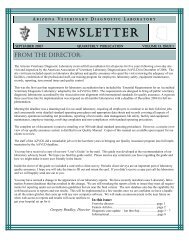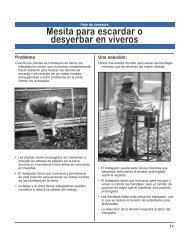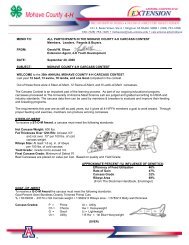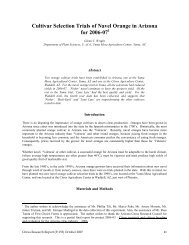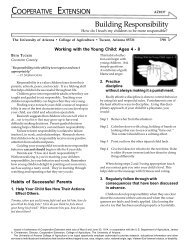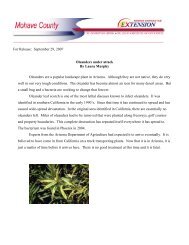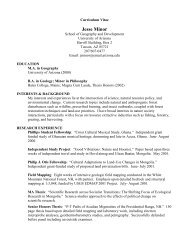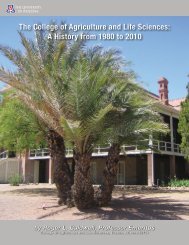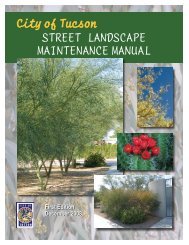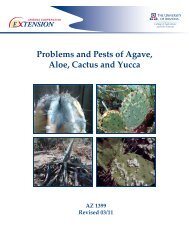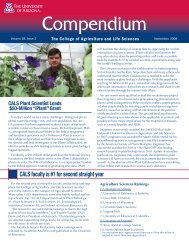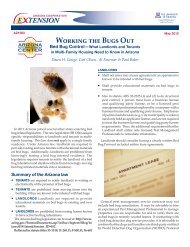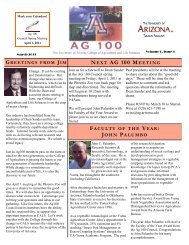Mesquite and Palo Verde Trees - University of Arizona
Mesquite and Palo Verde Trees - University of Arizona
Mesquite and Palo Verde Trees - University of Arizona
Create successful ePaper yourself
Turn your PDF publications into a flip-book with our unique Google optimized e-Paper software.
ARIZONA COOPERATIVE<br />
E TENSION<br />
AZ1429<br />
<strong>Mesquite</strong><br />
<strong>Mesquite</strong> trees are members <strong>of</strong> the genus Prosopis <strong>and</strong><br />
the Fabaceae (legume or bean) family. Because <strong>of</strong> their<br />
attractiveness <strong>and</strong> drought tolerance, they are one <strong>of</strong> the<br />
“backbone” plants <strong>of</strong> many xeriscape plantings. They<br />
tolerate most soils with good drainage <strong>and</strong> grow well in full<br />
to reflected sun as well as in partial shade. They range in<br />
size from shrubs to large trees that grow to over 30 feet (10<br />
meters) in height. They are native to North America, South<br />
America, Africa, India, <strong>and</strong> the Middle East.<br />
In <strong>Arizona</strong>, native mesquites grow along dry stream beds,<br />
in washes, flood plains, along rivers, on plains <strong>and</strong> hillsides,<br />
<strong>and</strong> in grassl<strong>and</strong>s. Where water is not a limiting growth<br />
factor, the trees reach their true majestic size. At elevations<br />
above 5000 feet (1525 meters) their growth is retarded due<br />
to cold <strong>and</strong> plants may appear as low growing shrubs.<br />
All mesquites are heat tolerant <strong>and</strong> grow rapidly during<br />
hot weather provided there is adequate water available.<br />
<strong>Mesquite</strong>s are deciduous, <strong>and</strong> foliage is shed in response to<br />
cold temperatures <strong>and</strong> prolonged drought conditions.<br />
The different species <strong>of</strong> mesquite can be distinguished<br />
by tree form, size, shape, <strong>and</strong> bark characteristics, but<br />
foliage is particularly useful in determining the species.<br />
Line drawings <strong>of</strong> leaves for the mesquite species discussed<br />
accompany the descriptions <strong>of</strong> the plants (Fig. 1 – 6, <strong>and</strong> 8).<br />
Leaves are bipinnate, meaning that leaflets are arranged<br />
along a central axis (pinna) similar to a feather, <strong>and</strong> each leaf<br />
has one or several pairs <strong>of</strong> pinnae. Flowers <strong>of</strong> all mesquites<br />
are catkin-like <strong>and</strong> develop into seed pods <strong>of</strong> various shapes<br />
<strong>and</strong> sizes.<br />
Historically, mesquite wood has been used by early<br />
peoples as a source <strong>of</strong> food, building materials <strong>and</strong> firewood.<br />
A nutritious meal is made from ground mesquite seed pods<br />
which helped sustain early Native Americans. Owing to<br />
the high protein content <strong>of</strong> the seeds, shoots <strong>and</strong> pods, it<br />
is an important food for range cattle. Currently there is a<br />
resurgence in the manufacture <strong>of</strong> mesquite furniture <strong>and</strong><br />
flooring due to the natural beauty <strong>of</strong> the wood, its intricate<br />
grain, coloration <strong>and</strong> durability. Many trees are converted<br />
into charcoal <strong>and</strong> are sold as a favorite barbecue wood that<br />
College <strong>of</strong> Agriculture <strong>and</strong> Life Sciences<br />
<strong>Mesquite</strong> <strong>and</strong> <strong>Palo</strong> <strong>Verde</strong> <strong>Trees</strong><br />
for the Urban L<strong>and</strong>scape<br />
Ursula K. Schuch <strong>and</strong> Jack J. Kelly<br />
is renowned for its unique southwestern flavor. This has<br />
taken its toll on some <strong>of</strong> the oldest <strong>and</strong> largest trees in the<br />
wild. Bees produce a fine quality honey from the mesquite<br />
flowers.<br />
<strong>Mesquite</strong> Species <strong>and</strong> Hybrids<br />
Prosopis alba (Argentine mesquite)<br />
Figure 1: Leaf <strong>of</strong> Prosopis alba<br />
Revised 04/12<br />
The mature height <strong>and</strong> spread <strong>of</strong> this species may<br />
be 20 – 50 feet (6 – 16 meters). Argentine mesquite has<br />
been misidentified as Chilean mesquite for many years.<br />
Argentine mesquite is characterized by airy blue-green<br />
foliage on sometimes spiny stems (Fig. 1). The tree may<br />
have thorns or may be thornless. It becomes leafless after<br />
the first hard freeze <strong>of</strong> winter <strong>and</strong> is typically dormant for<br />
6 – 8 weeks. When planted at elevations below 2500 feet<br />
(762 meters), it may remain semi-evergreen through the<br />
winter. If the winter is exceptionally mild, leaf drop may<br />
not occur until March which coincides with the first flush<br />
<strong>of</strong> new growth. Leaves <strong>of</strong> Argentine mesquite have 1 – 3<br />
pairs <strong>of</strong> pinnae each with 25 – 50 pairs <strong>of</strong> leaflets. Flowers<br />
are catkin-like 2 – 3 inches (5 – 8 cm) long <strong>and</strong> pale yellow,<br />
followed by 3 – 5 inch (8 – 12 cm) long seed pods which<br />
ripen in July <strong>and</strong> August.
Prosopis chilensis (Chilean mesquite)<br />
Figure 2: Leaf <strong>of</strong> Prosopis chilensis<br />
This mesquite is characterized by a lacy crown <strong>of</strong> bluegreen<br />
foliage on spiny stems (Fig. 2). Spines may be up<br />
to 2 inches (5 cm) in length which may limit its use in<br />
residential or high traffic areas. The trunk is typically dark<br />
brown <strong>and</strong> fissured. In the low <strong>and</strong> mid-desert, below<br />
2,500 feet (762 meters), the tree will lose most <strong>of</strong> its foliage<br />
except in years <strong>of</strong> mild winter temperatures when foliage<br />
may remain on the tree until March. Old leaves do not fall<br />
from the tree until new growth is well underway. During<br />
cold winters the tree will be dormant <strong>and</strong> leafless for 6<br />
– 8 weeks during winter. New foliage will appear in late<br />
March or early April <strong>and</strong> is fern-like <strong>and</strong> a beautiful light<br />
green. Leaves are characterized by 1 – 3 pairs <strong>of</strong> pinnae<br />
each with 10 – 29 pairs <strong>of</strong> widely spaced leaflets. Flowers<br />
are 1 – 3 inches (2.5 - 7.6 cm) in length <strong>and</strong> light yellow.<br />
Flowers are followed by 2 – 5 inch (5 – 13 cm) bean pods<br />
that ripen in July.<br />
Prosopis gl<strong>and</strong>ulosa var. gl<strong>and</strong>ulosa (Texas honey mesquite)<br />
Figure 3: Leaf <strong>of</strong> Prosopis gl<strong>and</strong>ulosa var. gl<strong>and</strong>ulosa<br />
This attractive ornamental tree grows to a mature height<br />
<strong>of</strong> 15 – 30 feet (5 – 10 meters) <strong>and</strong> is characterized by its<br />
weeping habit <strong>and</strong> shiny foliage which resembles Schinus<br />
molle (California pepper tree). It has small reddish thorns<br />
<strong>and</strong> creamy white flowers. Leaves have 1 – 2 pairs <strong>of</strong> pinnae<br />
with 6 – 17 pairs <strong>of</strong> secondary leaflets per pinna (Fig. 3). The<br />
2 The <strong>University</strong> <strong>of</strong> <strong>Arizona</strong> Cooperative Extension<br />
trunk is tan <strong>and</strong> smooth when young but becomes rougher<br />
<strong>and</strong> darker as the tree matures. Texas honey mesquite is<br />
native to the southwestern U.S. including Texas, Oklahoma,<br />
Kansas <strong>and</strong> into northern Mexico.<br />
Due to its ornamental popularity, several selections<br />
have been made for foliage, form <strong>and</strong> thornlessness. These<br />
cultivars are vegetatively propagated to insure the integrity<br />
<strong>of</strong> the clone. Texas honey mesquites require well drained<br />
soil <strong>and</strong> tolerate full sun or partial sun. Once established,<br />
plants irrigated monthly develop into larger trees with a<br />
dense canopy.<br />
Figure 4: Leaf <strong>of</strong> Prosopis gl<strong>and</strong>ulosa var. torreyana<br />
P. gl<strong>and</strong>ulosa var. torreyana is similar in character to Texas<br />
honey mesquite, but has smaller leaves with one pair <strong>of</strong><br />
pinnae <strong>and</strong> 8 – 24 pairs <strong>of</strong> leaflets per pinna (Fig. 4). It is<br />
native to west Texas, California, New Mexico <strong>and</strong> parts <strong>of</strong><br />
<strong>Arizona</strong> <strong>and</strong> Mexico. This variety can sometimes be found<br />
in nurseries.<br />
Prosopis nigra (Black mesquite, Algarrobo negro)<br />
Figure 5: Leaf <strong>of</strong> Prosopis nigra
P. nigra is native to Argentina, Paraguay <strong>and</strong> parts <strong>of</strong><br />
Uruguay. It resembles P. alba in many respects <strong>and</strong> has<br />
very similar form <strong>and</strong> foliage (Fig. 5). The leaflets <strong>of</strong> P. nigra<br />
are closely packed in dark green compound leaves. Leaves<br />
have 1 – 3 pairs <strong>of</strong> pinnae with 20 – 30 pairs <strong>of</strong> leaflets per<br />
pinna. Trunk color is dark brown to black. Unlike many<br />
members <strong>of</strong> the Prosopis genus, black mesquite is evergreen<br />
under most conditions. The plant form is quite variable<br />
<strong>and</strong> may be heavily thorned. With deep soil <strong>and</strong> adequate<br />
moisture the tree may grow to 30 feet (10 meters) in height<br />
<strong>and</strong> width. It will tolerate being grown in irrigated turf<br />
areas <strong>and</strong> full-sun exposure. The wood is prized because<br />
<strong>of</strong> its beautiful brown streaking <strong>and</strong> is used to make<br />
furniture <strong>and</strong> barrels. Flowers are typical catkin-like up to<br />
2.5 inches (6 cm) long <strong>and</strong> yellow, <strong>and</strong> are followed by seed<br />
pods that are 4 – 6 inches (10 – 15 cm) long <strong>and</strong> are <strong>of</strong>ten<br />
streaked with pink. P. nigra is currently underused as it<br />
is not commonly available in the trade, although it is an<br />
excellent tree for the low <strong>and</strong> mid-elevation desert.<br />
Prosopis pubescens (Screwbean mesquite, Tornillo)<br />
Figure 6: Leaf <strong>and</strong> seed pod <strong>of</strong> Prosopis pubescens<br />
Screwbean mesquite grows to about 25 feet (7.6 meters)<br />
with an equal spread. P. pubescens is native to the Sonoran<br />
<strong>and</strong> Chihuahuan deserts in parts <strong>of</strong> southern <strong>Arizona</strong>,<br />
Texas, <strong>and</strong> New Mexico. The tree is characterized by<br />
unique seed pods that appear as a tightly wound spring or<br />
a screw, hence the common name (Fig. 6). “Tornillo” means<br />
screw in Spanish. The tree is typically multi-stemmed <strong>and</strong><br />
the bark on older branches is shaggy, flaky <strong>and</strong> easily<br />
peels from the tree. Typical form <strong>of</strong> the tree is vase-like,<br />
very open <strong>and</strong> spreading. The leaves are smaller than the<br />
other mesquites described above <strong>and</strong> are characterized by<br />
one pair <strong>of</strong> pinnae with 5 – 9 pairs <strong>of</strong> leaflets per pinna.<br />
Each leaflet is approximately 3/8 to 1 inch (1 – 2.5 cm) in<br />
length (Fig. 6). The small ¾ inch (2 cm) spines are whitish,<br />
slender <strong>and</strong> appear as pairs along the branches. Catkinlike<br />
flowers are bright yellow. This tree grows very slowly<br />
without irrigation.<br />
Prosopis velutina (Velvet mesquite)<br />
Figure 7: Prosopis velutina in winter (above) <strong>and</strong> spring<br />
(below)<br />
Figure 8: Leaf <strong>and</strong> seed pod <strong>of</strong> Prosopis velutina<br />
Mature size <strong>of</strong> velvet mesquite is 30 – 50 feet (9 – 15 meters)<br />
height <strong>and</strong> spread (Fig. 7) when grown with adequate water<br />
<strong>and</strong> in deep soils. Growth rate is slow to moderate but<br />
moderate to rapid under irrigation. Velvet mesquite is<br />
The <strong>University</strong> <strong>of</strong> <strong>Arizona</strong> Cooperative Extension<br />
3
native from central <strong>and</strong> southern <strong>Arizona</strong> into Mexico. It<br />
grows as a shrub on dry rocky upl<strong>and</strong> sites but will grow<br />
much larger under ideal conditions. This tree may be<br />
found as a single-stemmed tree in bosques (thickets) or as<br />
a multi-stemmed tree in open areas. The bark is fissured,<br />
dark brown <strong>and</strong> rough. The wood is prized for furniture<br />
because <strong>of</strong> its unique coloration <strong>and</strong> intricate grain. <strong>Trees</strong><br />
may grow up to 4 feet (1.2 meters) in trunk diameter <strong>and</strong><br />
live for several hundred years. Velvet mesquite foliage is<br />
covered with dense short gray hairs that cover most parts<br />
<strong>of</strong> a younger plant (Fig. 8).<br />
Filtered shade from velvet mesquites is light <strong>and</strong> <strong>of</strong>ten<br />
serves as a nurse tree for other slower growing plants such<br />
as cactus <strong>and</strong> shrubs. Leaves have one or two pairs <strong>of</strong><br />
pinnae (Fig. 8) with 12 – 30 pairs <strong>of</strong> leaflets each. In late<br />
fall or early winter after the first hard freeze, the graygreen,<br />
fine textured leaflets turn light green or tan <strong>and</strong> fall<br />
from the tree revealing a beautifully sculptured trunk <strong>and</strong><br />
scaffold branches. In spring two to three inch (5 – 7.5 cm)<br />
long cream-colored flowers adorn the tree followed by<br />
tan seed pods which ripen in mid to late summer. Young<br />
velvet mesquites have small thorns which become less<br />
problematic as the tree matures. Velvet mesquite trees are<br />
drought tolerant yet will flourish with moderate irrigation.<br />
They may become unstable due to rapid crown growth<br />
<strong>and</strong> a limited root system in lawn conditions.<br />
Hybrid mesquites<br />
<strong>Mesquite</strong>s cross-pollinate quite readily <strong>and</strong> as a<br />
result there are a group <strong>of</strong> plants that are simply called<br />
“hybrid mesquites”. They are <strong>of</strong>ten the result <strong>of</strong> natural<br />
hybridization <strong>of</strong> Prosopis alba (Argentine mesquite), P.<br />
chilensis (Chilean mesquite) <strong>and</strong> native P. velutina. Because<br />
<strong>of</strong> this hybridization, it is almost impossible to obtain pure<br />
species seed. Most hybrids are typically fast-growing,<br />
attractive, thorny or thornless, may have delicate blue<br />
green or green foliage or may have small leaves <strong>and</strong> have<br />
intermediate characteristics <strong>of</strong> the above described species.<br />
Many <strong>of</strong> the hybrid mesquite leaves persist until the new<br />
growth begins in spring, giving the tree an almost evergreen<br />
appearance. These hybrids are <strong>of</strong>ten sold in the trade as<br />
“Chilean” mesquite or “South American Hybrids”.<br />
Hybrid mesquites are noted for their rapid growth <strong>and</strong><br />
can attain a mature height <strong>of</strong> 9 – 40 feet (3 – 13 meters) with<br />
a spread <strong>of</strong> up to 30 feet (9 meters). They make an excellent<br />
large shade tree but given their size, are <strong>of</strong>ten unsuited<br />
for the smaller yards found in newer subdivisions. Many<br />
homeowners seek out the thornless hybrids <strong>and</strong> as a result,<br />
selections <strong>of</strong> trees having no thorns <strong>and</strong> superior structural<br />
<strong>and</strong> aesthetic characteristics have been made. To preserve<br />
these characteristics, trees either are grown from cuttings,<br />
are air layered, or are grafted. Thorns, which are modified<br />
leaves, <strong>of</strong>ten disappear as the tree matures. In situations<br />
where thorns (which can be up to 2 inches (5 cm) long) are<br />
objectionable, they may be pruned <strong>of</strong>f young trees <strong>and</strong> will<br />
not re-grow from this location again.<br />
4 The <strong>University</strong> <strong>of</strong> <strong>Arizona</strong> Cooperative Extension<br />
Culture<br />
All mesquites are very tolerant <strong>of</strong> hot south <strong>and</strong> westfacing<br />
walls, are valuable trees in parks or large public<br />
areas, <strong>and</strong> are an asset in low water-use l<strong>and</strong>scapes. They<br />
may be planted in groups or as solitary specimens <strong>and</strong><br />
add a lush appearance to the l<strong>and</strong>scape. <strong>Mesquite</strong>s are<br />
well suited to heat, low humidity, alkaline <strong>and</strong> poor soils.<br />
<strong>Mesquite</strong> trees are not well suited as street trees due to their<br />
multi-trunk character. The cold tolerance <strong>of</strong> many species<br />
has been established but this tolerance is quite variable<br />
owing to the condition <strong>of</strong> the plant at the onset <strong>of</strong> winter.<br />
Heavily fertilized <strong>and</strong> irrigated trees will not tolerate the<br />
cold as well as those that have been conditioned with less<br />
water <strong>and</strong> no fertilizer late in the summer. Honey mesquite<br />
(Prosopis gl<strong>and</strong>ulosa) <strong>and</strong> screwbean mesquite (P. pubescens)<br />
can survive temperatures to 0 ºF (–18 ºC); velvet mesquite<br />
(P. velutina) is reliably cold hardy to at least 10 ºF (–12 ºC);<br />
Chilean mesquite (P. chilensis) <strong>and</strong> black mesquite (P. nigra)<br />
are hardy to at least 15 ºF (–9 ºC); Argentine mesquite (P.<br />
alba) <strong>and</strong> many South American hybrids suffer damage<br />
<strong>and</strong> dieback when temperatures fall below 15 – 20 ºF (–9 to<br />
–7 ºC). Where there is abundant water present, mesquite<br />
specimens will be largest when grown in deep, uniform,<br />
s<strong>and</strong>y soils in <strong>and</strong> along streambeds, <strong>and</strong> alluvial plains.<br />
With proper irrigation, these trees will grow satisfactorily<br />
on any well drained soil.<br />
Problems<br />
Figure 9. True mistletoe aerial shoots with berries.<br />
There are few problems <strong>of</strong> mesquites. Mistletoe<br />
(Phoradendron californicum) can be a nuisance or develop<br />
into a more serious problem for heavily infested trees.<br />
True mistletoe contains chlorophyll <strong>and</strong> carries on<br />
photosynthesis, but being a parasite it also lives <strong>of</strong>f the<br />
nutrients <strong>of</strong> the host plant (Fig. 9). It can develop into<br />
plants that are several feet in diameter. Mistletoes may be a<br />
problem if left unmanaged <strong>and</strong> while it generally does not<br />
kill a tree, it can cause significant decline over time. If not<br />
pruned out, the weight <strong>of</strong> the mistletoe can become great<br />
enough that the branch may break <strong>of</strong>f. Manual removal
<strong>of</strong> mistletoe is the only practical control however, removal<br />
does not kill the mistletoe as it continues to grow inside the<br />
wood. Since mistletoe is a part <strong>of</strong> the desert ecology, it is<br />
an aesthetic decision whether to remove it or not on lightly<br />
infested trees. Mistletoe berries are a primary food source<br />
<strong>of</strong> desert birds <strong>and</strong> only in few situations the mistletoe<br />
becomes large enough to warrant removal.<br />
Figure 10: Slime flux on Prosopis sp.<br />
Slime flux is caused by the infection <strong>of</strong> sapwood by<br />
several bacteria <strong>and</strong> is a problem with mature mesquites.<br />
The disease causing microorganisms are found in the soil<br />
<strong>and</strong> probably gain entry through above or below the soil<br />
line wounds or pruning cuts. After several years, affected<br />
areas will exhibit a water-soaked appearance (wet wood).<br />
Gas is produced by the bacteria (<strong>and</strong> possibly yeasts) which<br />
force out a foul smelling liquid from cracks <strong>and</strong> wounds.<br />
The liquid is dark brown to black in color (Fig. 10). Infected<br />
trees live many years <strong>and</strong> slime flux is more <strong>of</strong> a nuisance<br />
that requires periodically a strong, hard stream <strong>of</strong> water<br />
to prevent staining <strong>of</strong> patios <strong>and</strong> cars. Seriously infected<br />
branches may need removal if they present a safety hazard.<br />
The old remedy <strong>of</strong> placing drainage tubes into the infected<br />
areas is not recommended <strong>and</strong> may in fact, present more<br />
entry sites for the disease.<br />
Figure 11: A shelf-shaped mushroom <strong>of</strong> a wood decay fungus<br />
(Ganoderma sp).<br />
Ganoderma root rot (Ganoderma) is caused by a soilborne<br />
fungus <strong>and</strong> enters mesquite roots primarily through<br />
wound sites. Root rot causes slow decline <strong>and</strong> eventually<br />
death <strong>of</strong> mature trees. There is no recommended treatment<br />
for infected trees. Fruiting bodies at the base <strong>of</strong> the tree<br />
are most common during the summer rainy season. They<br />
start as white structures at the base <strong>of</strong> the tree <strong>and</strong> develop<br />
into light brown, shelf like fruiting bodies (Fig. 11).<br />
Figure 12: Nymph <strong>of</strong> giant mesquite bug<br />
(Thasus neocalifornicus)<br />
During the summer months, the giant mesquite bug<br />
(Thasus gigas) makes its appearance. Although it looks<br />
threatening because <strong>of</strong> its size <strong>and</strong> dramatic markings, it<br />
is just another insect that is part <strong>of</strong> the desert ecology. No<br />
control is recommended for these insects as their damage<br />
is minimal. The adults are up to two inches (5 cm) long<br />
<strong>and</strong> have brown <strong>and</strong> yellow markings on their forewings<br />
<strong>and</strong> red <strong>and</strong> black b<strong>and</strong>ing on their legs. What makes these<br />
insects interesting is that the immature insects (nymphs)<br />
are b<strong>and</strong>ed an attractive red <strong>and</strong> white <strong>and</strong> may appear in<br />
large numbers in early April (Fig. 12). Although menacing<br />
looking, they are not considered a damaging pest <strong>of</strong><br />
mesquites.<br />
Another minor pest <strong>of</strong> mesquite is the mesquite twig<br />
girdler (Oncideres rhodosticta) which may appear in early to<br />
mid-summer. The adult cuts a channel around the stem <strong>and</strong><br />
deposits her eggs in now girdled portions. The resulting<br />
damage is “flagging” or browning <strong>of</strong> the girdled stems.<br />
Since the damage is cosmetic, no control is recommended.<br />
Miscellaneous wood borers may appear from time to time<br />
in older, neglected or stressed trees. These beetles are<br />
typically drawn to trees that are under severe stress <strong>and</strong><br />
are considered secondary pests.<br />
Irrigation related issues can cause problems for<br />
mesquite trees or surrounding vegetation. Infrequent<br />
shallow watering for turf will encourage surface rooting<br />
rather than the deep root development that proper<br />
irrigation <strong>of</strong> trees will provide. <strong>Mesquite</strong> trees can become<br />
unstable with excess irrigation, such as in lawns, due to<br />
rapid crown growth <strong>and</strong> limited root system development.<br />
The <strong>University</strong> <strong>of</strong> <strong>Arizona</strong> Cooperative Extension<br />
5
Another irrigation related problem is improper placement<br />
<strong>of</strong> drip emitters. By placing emitters close to the trunk,<br />
roots primarily develop in these areas. Placing the emitters<br />
further out (at the dripline <strong>of</strong> the tree <strong>and</strong> beyond) will help<br />
establish a root system which gives stability to the tree <strong>and</strong><br />
reduces the occurrence <strong>of</strong> tree toppling <strong>and</strong> possible tree<br />
loss.<br />
Root binding can be a problem <strong>of</strong> mesquite <strong>and</strong> palo<br />
verde trees when purchased in containers. Most mesquite<br />
but also some <strong>of</strong> the palo verde species grow very fast<br />
under cultivation. If not transplanted to larger containers<br />
in a timely manner, roots start circling around the outside<br />
<strong>of</strong> the root ball <strong>and</strong> in some cases close around the trunk.<br />
If not corrected by pruning circling roots at transplanting,<br />
this condition can lead to problems <strong>of</strong> tree failure.<br />
<strong>Palo</strong> <strong>Verde</strong> Species <strong>and</strong> Cultivars<br />
Figure 13: Pr<strong>of</strong>use bloom on Parkinsonia florida<br />
<strong>Palo</strong> verdes are popular, drought tolerant l<strong>and</strong>scape trees<br />
in the genus Parkinsonia (formerly Cercidium) <strong>and</strong> the family<br />
Fabaceae. <strong>Palo</strong> verdes range from large shrubs to medium<br />
sized trees <strong>and</strong> are native in the Sonoran Desert except for<br />
P. praecox which is native from Mexico to South America.<br />
Along with saguaro cactus, they are a staple <strong>of</strong> the Sonoran<br />
Desert <strong>and</strong> are used in many xeriscape plantings. Parkinsonia<br />
florida, blue palo verde, <strong>and</strong> P. microphylla, the Foothill palo<br />
verde, share the title <strong>of</strong> <strong>Arizona</strong>’s <strong>of</strong>ficial state tree.<br />
<strong>Palo</strong> verde trees prefer full sun <strong>and</strong> well drained soil in<br />
cultivated l<strong>and</strong>scapes. Growth rates vary depending on<br />
supplemental irrigation <strong>and</strong> species. Conspicuous green,<br />
smooth bark dominates the plant’s appearance during<br />
periods <strong>of</strong> drought <strong>and</strong> cold when trees are leafless <strong>and</strong> gives<br />
them their common name “palo verde” which in Spanish<br />
means “green stick”. Shoots are armed with small thorns<br />
at the nodes or the end <strong>and</strong> leaves are small, bipinnate. The<br />
green bark allows photosynthesis <strong>and</strong> with age turns from<br />
smooth with yellowish green color to rough with gray color.<br />
Besides the striking green bark, a pr<strong>of</strong>use show <strong>of</strong> yellow<br />
flowers in spring makes palo verdes popular l<strong>and</strong>scape<br />
trees. Line drawings <strong>of</strong> leaves, flowers <strong>and</strong> seed pods are<br />
6 The <strong>University</strong> <strong>of</strong> <strong>Arizona</strong> Cooperative Extension<br />
presented with each species to aid in identification (Fig. 14,<br />
15, 17 – 19).<br />
<strong>Palo</strong> verde plays an important role in the desert ecosystem<br />
providing habitat for wildlife <strong>and</strong> serving as a nurse plant<br />
for small cacti. Flowers produce much nectar for honey.<br />
Pods are sought by wildlife <strong>and</strong> livestock <strong>and</strong> provided a<br />
staple for indigenous people in the Southwest. Pods can<br />
create heavy litter.<br />
Parkinsonia aculeata (Mexican palo verde) is found in<br />
older l<strong>and</strong>scapes, but is no longer considered a desirable<br />
l<strong>and</strong>scape tree. Although a showy blooming tree, it is well<br />
armed, short-lived, produces heavy leaf litter, <strong>and</strong> reseeds<br />
freely on road sides, vacant lots, <strong>and</strong> in washes.<br />
Parkinsonia florida (Blue palo verde)<br />
Figure 14: Leaf, flower <strong>and</strong> seed pod <strong>of</strong> Parkinsonia florida<br />
The blue-green color <strong>of</strong> stems, branches, <strong>and</strong> densely<br />
growing twigs <strong>and</strong> the prolific bright yellow flowers in<br />
spring (Fig. 13) have made it one <strong>of</strong> the most popular palo<br />
verde species. Foliage is fine textured <strong>and</strong> consists <strong>of</strong> one<br />
pair <strong>of</strong> pinnae with 2 – 4 pairs <strong>of</strong> leaflets (Fig. 14). Blue palo<br />
verde flowers in mid-spring, about three weeks earlier than<br />
P. microphylla (Foothill palo verde). Blue palo verde has a<br />
moderate growth rate. It is adapted to desert soils, but can<br />
also tolerate lawn conditions. Native to washes <strong>and</strong> plains<br />
with deep soil, trees benefit from additional irrigation once<br />
or twice during the hot, dry season. This plant is native to<br />
the Sonoran Desert, northern Sinaloa <strong>and</strong> Baja California,<br />
Mexico, <strong>and</strong> can be found at elevations from sea level to<br />
4,000 feet (1,220 meters). Cold hardiness is reported to 10<br />
ºF (–12 ºC).
The pr<strong>of</strong>use amount <strong>of</strong> flowers <strong>and</strong> seed pods can create<br />
heavy litter under the tree canopy. Short thorns on twigs<br />
can be a problem near walkways. Blue palo verde generally<br />
require more pruning than other cultivated palo verdes,<br />
because they tend to spread more <strong>and</strong> have more secondary<br />
branches. Blue palo verde is susceptible to the palo verde<br />
borer, mistletoe, <strong>and</strong> witches’ broom (see under problems).<br />
Parkinsonia microphylla (Foothill palo verde, littleleaf palo<br />
verde)<br />
Figure 15: Leaf, flower <strong>and</strong> seed pod <strong>of</strong> Parkinsonia microphylla<br />
Figure 16 : Parkinsonia microphylla in full bloom<br />
Foothill palo verde trees grow 10 to 20 feet (3 to 6 meters)<br />
tall with equal spread. They are the slowest growing species<br />
among the Parkinsonia in cultivation. The canopy is dense<br />
with spiny branches <strong>and</strong> bark color is yellowish green.<br />
Leaflets are smallest among the species described here;<br />
leaves have one pair <strong>of</strong> pinnae with 4 – 8 pairs <strong>of</strong> leaflets each<br />
<strong>and</strong> appear on the tree only for a short time after summer or<br />
winter moisture in natural settings (Fig. 15). Flowers appear<br />
briefly <strong>and</strong> are pale yellow in color. Intensity <strong>of</strong> flowering<br />
varies by year <strong>and</strong> is generally heavier after a wet winter<br />
(Fig. 16).<br />
P. florida <strong>and</strong> P. microphylla can be differentiated by their<br />
flower colors. P. florida has five deep yellow petals whereas<br />
P. microphylla has four yellow <strong>and</strong> one whitish petal which<br />
give the plant an overall pale yellow color while in bloom.<br />
Seed pods <strong>of</strong> P. microphylla are 1.2 – 5 inches (3 – 13 cm),<br />
oblong, <strong>and</strong> are constricted between seeds (Fig. 15). They<br />
can create heavy litter.<br />
P. microphylla is native to the Sonoran Desert including<br />
Baja California in Mexico. This species requires well drained<br />
soil <strong>and</strong> does not tolerate lawn or well-watered conditions.<br />
Although extremely drought tolerant, trees might shed<br />
branches during prolonged drought. P. microphylla is<br />
tolerant <strong>of</strong> temperatures to 15 ºF (–9 ºC). Maintenance in<br />
the l<strong>and</strong>scape generally includes pruning <strong>of</strong> dead branches,<br />
mistletoe, witches’ broom or to expose lower stems.<br />
Similar to blue palo verde, P. microphylla trees are also<br />
susceptible to the palo verde borer. Foothill palo verde<br />
trees are available in cultivation <strong>and</strong> large specimens are<br />
successfully moved from the wild to developed areas.<br />
Parkinsonia praecox subsp. glauca (Argentine palo brea)<br />
This tree grows up to 20 feet (6 meters) tall <strong>and</strong> originated<br />
in Argentina. It has the characteristic green bark, yellow<br />
flowers, <strong>and</strong> tan pods <strong>of</strong> the genus. It looks very similar<br />
to the Sonoran palo brea (P. praecox subsp. praecox) but<br />
has smaller leaflets. The subspecies glauca is considered to<br />
have greater drought tolerance than the Sonoran palo brea,<br />
because it is native in areas that receive as little as 4 inches<br />
(80 – 100 mm) <strong>of</strong> annual rainfall. Supplemental irrigation<br />
will increase growth. Argentine palo brea is also thought<br />
to have greater cold hardiness to 10 ºF (–12 ºC) based on<br />
observations where the Sonoran palo brea suffered greater<br />
cold damage after frost than the Argentine palo brea. This<br />
open shrub is <strong>of</strong>ten trained to a small tree by removing<br />
lower limbs <strong>and</strong> can be used in areas such as medians <strong>and</strong><br />
patios where space may be limited. No problems have<br />
been observed on trees in the l<strong>and</strong>scape.<br />
“Brea” is the Spanish word for tar or pitch <strong>and</strong> refers to<br />
the waxy coating <strong>of</strong> the bark that can be scraped <strong>of</strong>f <strong>and</strong><br />
used as glue. The exudates from the bark are sweet <strong>and</strong><br />
edible <strong>and</strong> have been used to make soap. Medicinal use <strong>of</strong><br />
bark has been reported.<br />
The <strong>University</strong> <strong>of</strong> <strong>Arizona</strong> Cooperative Extension<br />
7
Parkinsonia praecox subsp. praecox (Sonoran palo brea, Brea)<br />
Figure 17: Leaf, flower <strong>and</strong> seed pod <strong>of</strong> Parkinsonia praecox<br />
subsp. praecox<br />
This small tree grows 15 to 30 feet (4.5 – 9 meters) tall<br />
with almost equal spread. This subspecies has the largest<br />
leaves <strong>of</strong> the genus (Fig. 17). Flowers are golden yellow,<br />
the bark is bright green to lime green with foliage <strong>of</strong><br />
blue green color. Seed pods are tan colored, oblong <strong>and</strong><br />
1.2 – 2.5 inches (3 – 6) cm in length <strong>and</strong> can create heavy<br />
litter. Growth rate is moderate to rapid <strong>and</strong> increases with<br />
supplemental irrigation. Plants tolerate a wide range <strong>of</strong><br />
soil conditions.<br />
Subspecies praecox is native to the widest range <strong>of</strong><br />
the genus <strong>and</strong> occurs from northwest Mexico in disjunct<br />
populations as far south as Argentina, <strong>and</strong> from near sea<br />
level to 6,560 feet (2000 meters) elevation. This subspecies is<br />
considered less tolerant to drought <strong>and</strong> cold temperatures<br />
than the subspecies glauca. Hardiness <strong>of</strong> plants from<br />
Sonora has been reported at 20 ºF (–7 ºC). Hybrids <strong>of</strong> P.<br />
praecox with P. microphylla or P. florida have been observed.<br />
Parkinsonia hybrids <strong>and</strong> cultivars<br />
Parkinsonia x ‘Desert Museum’ is the most popular<br />
hybrid <strong>of</strong> the genus <strong>and</strong> is a natural three- way cross <strong>of</strong> (P.<br />
aculeata x P. microphylla) x P. florida. Desirable horticultural<br />
characteristics <strong>of</strong> this tree include its upright growth habit,<br />
no thorns, fast growth with irrigation, smooth light green<br />
bark, <strong>and</strong> large masses <strong>of</strong> yellow flowers produced from<br />
March to May. Leaf size is intermediate between the parent<br />
taxa. P. x ‘Desert Museum’ has one or two pairs <strong>of</strong> pinnae<br />
8 The <strong>University</strong> <strong>of</strong> <strong>Arizona</strong> Cooperative Extension<br />
that are 2 – 4 inches (5 – 10 cm) in length <strong>and</strong> have 9 – 19<br />
pairs <strong>of</strong> leaflets per pinna. <strong>Trees</strong> reach a height <strong>of</strong> 21 to 25<br />
feet (7 – 8.3 meters) <strong>and</strong> grow as wide in canopy. The plant<br />
is hardy to 15 °F (–9 °C). Plants need to be propagated<br />
vegetatively to retain the characteristics <strong>of</strong> the parent tree.<br />
Figure18: Leaf <strong>of</strong> Parkinsonia x ‘Desert Museum’<br />
Figure 19: Leaf, flower <strong>and</strong> seed pod <strong>of</strong> Parkinsonia x sonorae
Another palo verde hybrid, Parkinsonia x sonorae (Sonoran<br />
palo verde) is a cross <strong>of</strong> P. microphylla x P. praecox. This small<br />
tree grows 10 to 20 feet (3.3 to 6.3 meters) high <strong>and</strong> as wide,<br />
but is not widely available in the trade.<br />
A few other cultivars available in the trade have been<br />
selected by nurseries for desirable aesthetic appearance or<br />
improved cold hardiness.<br />
Culture<br />
<strong>Palo</strong> verde trees are extremely drought tolerant once<br />
established, but vary in their tolerance to irrigation. P.<br />
florida is most tolerant <strong>of</strong> the genus <strong>of</strong> frequently irrigated<br />
conditions such as lawns, while P. microphylla does not<br />
tolerate frequent irrigation. Even when tolerant <strong>of</strong> turf<br />
conditions, desert trees including palo verde are not<br />
recommended in turf. The shallow frequent irrigations to<br />
maintain turf can lead to possible tree toppling <strong>and</strong> loss. In<br />
addition, sun-loving grass species such as bermuda grass<br />
do not grow well in the shade below the tree.<br />
P. microphylla is extremely susceptible to deep planting or<br />
having the base <strong>of</strong> the trunk covered with soil. Prolonged<br />
exposure to soil at the trunk base predisposes the tree to rot<br />
<strong>and</strong> tree failure.<br />
Problems<br />
Figure 20: Witches’ broom on palo verde<br />
Witches’ broom causes a proliferation <strong>of</strong> dense twig<br />
growth, but the cause <strong>of</strong> the problem is unclear at this<br />
time (Fig. 20). Removal <strong>of</strong> affected branches is the only<br />
management method to date, but the broom regrows soon<br />
after removal. P. florida (blue palo verde) is the primary<br />
species affected by this disorder.<br />
True mistletoe can affect all Parkinsonia species.<br />
Description <strong>and</strong> control methods are the same as described<br />
under the mesquite problem section.<br />
<strong>Palo</strong> verde root borer (Derobrachus geminatus) is the larval<br />
grub stage <strong>of</strong> the 3 – 3.5 inch (8 – 9 cm) palo verde beetle.<br />
The adult beetle is dark brown to black <strong>and</strong> has prominent<br />
antennae approximately half the overall length <strong>of</strong> the insect.<br />
The larval stage is up to 5 inches (12.7 cm) in length <strong>and</strong><br />
attacks the roots <strong>of</strong> many desert trees including palo verdes.<br />
Adult insects emerge from 1 inch (2.5 cm) wide holes in the<br />
soil during summer rains. Upon the removal <strong>of</strong> dead palo<br />
verde trees, the grub is usually present in the roots, hence<br />
the name. No control measures are recommended.<br />
<strong>Palo</strong> verde webbers (Bryotropha inaequalis) emerge in<br />
spring <strong>and</strong> become apparent because <strong>of</strong> the silken tubes in<br />
which they live. The fine webbing appears soon after leaves<br />
emerge after winter rains on P. microphylla. Small caterpillars<br />
are up to ½ inch long <strong>and</strong> slender. <strong>Palo</strong> verde webbers<br />
appear only seasonally <strong>and</strong> are not a pest warranting control<br />
measures.<br />
References<br />
Johnson, M. 1996. <strong>Palo</strong> verde – a review <strong>of</strong> the genus<br />
Cercidium. Aridus 8(3):1 – 6.<br />
Jones, W. <strong>and</strong> C. Sacamano. 2000. L<strong>and</strong>scape Plants for Dry<br />
Regions. Fisher Books, Tucson, AZ.<br />
Burkart, A. 1976. A Monograph <strong>of</strong> the Genus Prosopis<br />
(Leguminosae subfam. Mimosoideae). Journal <strong>of</strong> the Arnold<br />
Arboretum 57(3, 4): 219-249, 450-525.<br />
Acknowledgements<br />
Line drawings are courtesy <strong>of</strong> Matt Johnson (except for<br />
one drawing done by Lucretia Hamilton), photo in fig. 12<br />
(giant mesquite bug nymph) courtesy <strong>of</strong> Carl Olson, photos<br />
in fig. 9 <strong>and</strong> fig.11 are courtesy <strong>of</strong> Dr. Mary Olsen.<br />
The <strong>University</strong> <strong>of</strong> <strong>Arizona</strong> Cooperative Extension<br />
9
The UniversiTy <strong>of</strong> ArizonA<br />
College <strong>of</strong> AgriCUlTUre And life sCienCes<br />
TUCson, ArizonA 85721<br />
UrsUlA K. sChUCh<br />
Specialist <strong>and</strong> Pr<strong>of</strong>essor, Plant Science<br />
JACK J. Kelly<br />
Emeritus Agent, Pima County Cooperative Extension<br />
ConTACT:<br />
ARIZONA COOPERATIVE<br />
E TENSION<br />
THE UNIVERSITY OF ARIZONA COLLEGE OF AGRICULTURE AND LIFE SCIENCES<br />
UrsUlA K. sChUCh<br />
ukschuch@cals.arizona.edu<br />
This information has been reviewed by university faculty.<br />
cals.arizona.edu/pubs/garden/az1429.pdf<br />
Originally published: 2003<br />
Other titles from <strong>Arizona</strong> Cooperative Extension can be found at:<br />
cals.arizona.edu/pubs<br />
Issued in furtherance <strong>of</strong> Cooperative Extension work, acts <strong>of</strong> May 8 <strong>and</strong> June 30, 1914, in cooperation with the U.S. Department <strong>of</strong> Agriculture, Jeffrey<br />
C. Silvertooth, Associate Dean & Director, Economic Development & Extension, College <strong>of</strong> Agriculture <strong>and</strong> Life Sciences, The <strong>University</strong> <strong>of</strong> <strong>Arizona</strong>.<br />
The <strong>University</strong> <strong>of</strong> <strong>Arizona</strong> is an equal opportunity, affirmative action institution. The <strong>University</strong> does not discriminate on the basis <strong>of</strong> race, color, religion,<br />
sex, national origin, age, disability, veteran status, or sexual orientation in its programs <strong>and</strong> activities.



